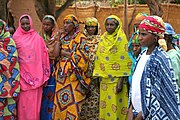Portal:Central African Republic
The Central African Republic (CAR), formerly known as Ubangi-Shari, is a landlocked country in Central Africa. It is bordered by Chad to the north, Sudan to the northeast, South Sudan to the east, the Democratic Republic of the Congo to the south, the Republic of the Congo to the southwest, and Cameroon to the west. Bangui is the country's capital and largest city, bordering the Democratic Republic of the Congo. The Central African Republic covers a land area of about 620,000 square kilometres (240,000 sq mi). As of 2024, it has a population of 5,357,744, and is in the scene of a civil war, which has been ongoing since 2012. As a former French colony, French is the official language, with Sango, a Ngbandi based-creole language as the national and co-official language. The Central African Republic mainly consists of Sudano-Guinean savannas, but the country also includes a Sahelo-Sudanian zone in the north and an equatorial forest zone in the south. Two-thirds of the country is within the Ubangi River basin (which flows into the Congo), while the remaining third lies in the basin of the Chari, which flows into Lake Chad. What is today the Central African Republic has been inhabited since at least 8,000 BCE. The country's borders were established by France, which ruled the country as a colony starting in the late 19th century. After gaining independence from France in 1960, the Central African Republic was ruled by a series of autocratic leaders, including an abortive attempt at a monarchy under the regime of Jean-Bedel Bokassa. By the 1990s, calls for democracy led to the first multi-party democratic elections in 1993. Ange-Félix Patassé became president, but was later removed by General François Bozizé in a 2003 coup. The Central African Republic Bush War began in 2004 and, despite a peace treaty in 2007 and another in 2011, civil war resumed in 2012. The civil war perpetuated the country's poor human rights record: it was characterized by widespread and increasing abuses by various participating armed groups, such as arbitrary imprisonment, torture, and restrictions on freedom of the press and freedom of movement. (Full article...) The Central African Republic Civil War is an ongoing civil war in the Central African Republic (CAR) involving the government, rebels from the Séléka coalition, and Anti-balaka militias. In the preceding Central African Republic Bush War (2004–2007), the government of President François Bozizé fought with rebels until a peace agreement in 2007. The current conflict arose when a new coalition of varied rebel groups, known as Séléka, accused the government of failing to abide by the peace agreements, captured many towns in 2012 and seized the capital in 2013. Bozizé fled the country, and the rebel leader Michel Djotodia declared himself president. Renewed fighting began between Séléka and militias opposed to them called Anti-balaka. In September 2013, President Djotodia disbanded the Séléka coalition, which had lost its unity after taking power, and resigned in 2014. He was replaced by Catherine Samba-Panza, but the conflict continued. In July 2014, ex-Séléka factions and Anti-balaka representatives signed a ceasefire agreement. By the end of 2014, the country was de facto partitioned with the Anti-Balaka controlling the south and west, from which most Muslims had evacuated, and ex-Séléka groups controlling the north and east. Faustin-Archange Touadéra, who was elected president in 2016, ran and won the 2020 election, which triggered the main rebel factions to form an alliance opposed to the election called the Coalition of Patriots for Change, which was coordinated by former president Bozizé. Peacekeeping largely transitioned from the ECCAS-led MICOPAX to the African Union-led MISCA to the United Nations-led MINUSCA, while the French peacekeeping mission was known as Operation Sangaris. (Full article...) The following are images from various Central African Republic-related articles on Wikipedia.
Entries here consist of Featured articles and Good articles, which consist of high-quality content on English Wikipedia..
Barthélemy Boganda (c. 1910 – 29 March 1959) was a Central African politician and independence activist. Boganda was active prior to his country's independence, during the period when the area, part of French Equatorial Africa, was administered by France under the name of Oubangui-Chari. He served as the first Premier of the Central African Republic as an autonomous territory. Boganda was born into a family of farmers, and was adopted and educated by Roman Catholic missionaries after the death of his parents. In 1938, he was ordained as a Roman Catholic priest. During World War II, Boganda served in a number of missions and afterwards was persuaded by the Bishop of Bangui to enter politics. In 1946, he became the first Oubanguian elected to the National Assembly of France, where he spoke out against racism and the abuses of the colonial regime. He then returned to Oubangui-Chari to form a political organisation, culminating in the 1949 foundation of the Movement for the Social Evolution of Black Africa (MESAN), which became popular among villagers and the peasantry. Boganda was laicized from the priesthood after developing a relationship with and eventually marrying Michelle Jourdain, a parliamentary secretary. Nonetheless, he continued to advocate for equal treatment and fundamental rights for blacks in the territory well into the 1950s. As France conceded measures of representation to its colonies, MESAN won local elections and he gained influence in Oubangui-Chari's government, though his reputation suffered when he backed an unsuccessful economic scheme. (Full article...)
* not the capital of the prefecture
The following Wikimedia Foundation sister projects provide more on this subject:
Discover Wikipedia using portals | ||||||||||||||||||||||||||||||||||||||||||||||||||||||||||||||||





























































